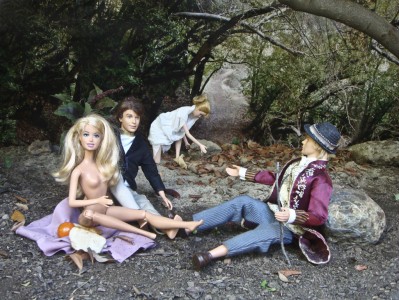
Bay Area photographer and artist Diane Cassidy celebrates her 82nd birthday this month with the showing of a new series of photographs at the annual San Francisco Altered Barbie show, and the launch of her first website. Cassidy studied photography at San Jose State University in the late 1980’s, and continues to take classes with respected photographers through various peninsula venues. A monograph of Cassidy’s work is scheduled for publication by Hunger Button Books in 2013.
Whirligig: How did you come to be an artist?
Diane: For me, becoming an artist was an indulgence. Throughout my formative years I was equally interested in making art and natural science. An unfortunate marriage ending in divorce left me, at a very early age, completely responsible for myself and my two children.
My first plan in preparing myself for a well-paying job was to get a degree in Art Education. Being young and impatient, I just couldn’t tolerate the necessary Mickey Mouse curricula; those how to educate courses were so so boring. I had trouble staying awake. One day while conversing with fellow classmates I learned that with a degree in a related science I could qualify for an internship in Medical Technology. I made the switch. How I relished those difficult chemistry and physics classes. A welcome relief.
During my 20 year stint as a Medical Technologist I was always taking art classes and workshops. Art was my hobby. Then one day in the 70’s while on vacation I stopped at the Script’s Institute. I noticed some images of shore life displayed on their walls that I really liked. Upon asking I learned that they were hi-contrast photographs. Thus began my foray into photography.
One day I attended a photo workshop in portraiture with Margo Davis at the Palo Alto Cultural Center. While she went over her bio she mentioned that though she had a BA in French from San Jose State, she returned to get a MA in photography. I had gotten a BA in Biology from San Jose State years ago; maybe I could return to get a MA in photography. Which I did. I retired as early as I could from Valley Medical Center and concentrated on photography in earnest.
Whirligig: Tell us about your experience in the graduate program at San Jose State. What did you come away with?
Diane: Beauty was not held in high regard. Angst was a necessary ingredient for producing meaningful artwork. A happy childhood doomed you. Postmodernism was the flavor of the day. Art was becoming more and more intellectual. So much so that many pieces needed an accompanying lengthy statement to help guide the viewer. Feminism was rampant. Postmodern French intellectuals, such as Baudrillard, Derrida, and Roland Barthe held sway elaborating on the deconstruction of language. There was immense pressure to be avant-garde, which ironically was frequently expressed via appropriation. I believe I was mostly immune to all this. I’m sure being an older student helped. I was 56 when I was accepted into the Masters Program.
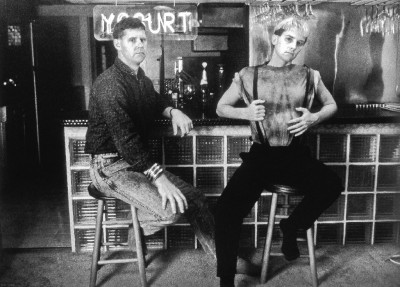
Whirligig: Did it meet your expectations? Was it worth it to you?
Diane: I had taken all the photography classes I could find locally including those at Sunnyvale Community Center and De Anza College. I was sorely in need of new challenges. What was most striking when I arrived at San Jose State was a huge difference in emphasis. At De Anza it was all technique: how to do this to get that. At San Jose State there was no how to instruction. Your value as a student was based completely on your ideas, your ability to render your inner anxieties and stresses into a two or three dimensional artwork. Plus your verbosity in expressing the inner meaning of whatever. The entire emphasis was on where you were coming from, how your earlier experience manifested itself in your art: the more obscure, the better. Angst was king!
Whirligig: What was your content during graduate school? Tell us about your thesis exhibition work.
Diane: My original choice for my thesis was to be a series of gum bichromate prints illustrating my favorite poem by my favorite poet, TS Eliot’s The Love song of J. Alfred Prufrock. With great difficulty and intensive labor involving combining photographs which had to be enlarged into big contact negatives I did produce a couple of prints, but midway through changed my direction. I can’t remember just why. Probably my early attempts were not well received.
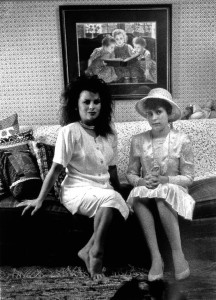
My second and final thesis work was Pairs of People where I originally wanted to photograph people resembling each other but settled on those who had a close association. I made an appointment with the couple to photograph them in their home, dressed as they usually did with the accustomed disorder. It was fun to see the way the pair related to each other and at the same time prepared themselves for a photograph. It was almost like a psychological study. I used a 4 x 5 camera, two flood lights, plus a diffusing screen using a sock filled with unpopped popcorn for a ballast. It seemed like I had a huge amount of equipment to take long distances in order to complete one assignment. For each couple I took eight photographs which I developed in my darkroom and then made the best into as large a print as my equipment could accommodate, 16 x 20. I matted and framed a total of 20. I later showed them at Gallery House in Palo Alto where the juror awarded me Best in Show.
Whirligig: What are your interests?
Diane: Art, science, philosophy, psychology, politics, alpha brain waves, Buddhism, metamorphosis.
Whirligig: The interest in art, science, psychology and metamorphosis comes across quite clear in the content of many of your individual and serial works. How have philosophy, alpha brain waves or Buddhism informed your work?
Diane: As far as I am aware I don’t really mix my two loves: science and art. I was thirty when I fell in love with Buddhism. I think at that age I was searching for a way to make meaning of my life possibly as a substitute for my almost lost belief in God. My last Blurb book was on metamorphosis. I still can’t decide if it’s an art book or a science book. So I guess mostly art is something I do whereas science is something I believe in.
Whirligig: I see your interest in science in many of your artworks, including your recent book Witness and your earlier book Five Frozen Embryos. But it is humor that seems to be a critical component of most of your work. Talk about this.

Diane: Humor is my safety net. Whenever I am aware of taking life or myself too seriously, I cease and desist. Five Frozen Embryos is a good example of how technology can seduce us into unwarranted self importance. Like my genes are better than your genes sort of thinking. The metamorphosis Witness book was a self-indulgent thoroughly enjoyable piece, a justification of the hours and hours I spent observing and photographing this amazing process. Not because I had to but because I wanted to.
Whirligig: My favorite work of yours is Doppelgängers. Tell us about making this work.
Diane: The idea wasn’t entirely mine. A student whose name I can’t remember who was part of my Masters program had, what I thought, a brilliant idea. It never came to fruition. He wanted to take large transparencies of a photograph encased in plastic and mounted on pedestals and placed in galleries. Each side would have a completely different story line. Showing the power that words have in interpreting a situation. The idea haunted me for years, eventually manifesting itself in my book Doppelgangers.
Whirligig: I recall you take the weekly New York Times because of their science section on Tuesday and that several of your artist’s books were inspired by newspaper articles. Would you say that reading, particularly newspapers, informs your creative work on some level?
Diane: I currently take the New York Times only on Sundays. At one time I subscribed to three newspapers, and in my self-designated morning routine I was free of all responsibilities until I’d read all three papers, cover to cover. This was back in the days when one single newspaper was chock full of information: local news, national news, human interest stories, etc. etc. I found so many “stranger than fiction” stories I believed no one but me was privy to (because no one else read the entire paper times three). Several fruits of this endeavor were The Five Frozen Embryos, Norm, about a pet desert tortoise who disappeared from a back yard in Palo Alto, my comic book Oscar Where Art Thou following the adventures of a misdirected corpse, and The Plight of the John Deere Lawnmower which David Lynch later made into a move The Straight Story.
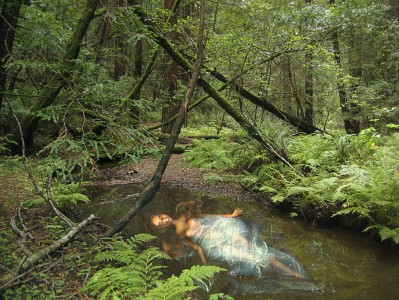
Whirligig: If you could have lunch with anybody, who would that be?
Diane: Annie Dillard, or maybe Margaret Atwood.
Whirligig: Why Annie Dillard or Margaret Atwood? What is it about these two writers that interests you?
Diane: I really don’t know why Margaret Atwood other than I am dazzled by her writing and I really like her demeanor (aura?). I more or less chose her randomly whereas Annie Dillard I consider my soul mate. The day I met her was when I was slumming with a friend (probably in the 80’s) and we stopped in a book store. I just happened to pick up a book I’d never heard of by an author I’d never heard of: Pilgrim at Tinker Creek by Annie Dillard. And just as randomly, I opened it to an extraordinary account of an incident, her personal experience, at Pilgrim Creek. It was about discovering what she thought was a frog floating on the water but slowly deflating and finally disappearing as it sank all because it was sucked up till empty by a giant water bug. Wow! It would be too difficult to explain the significance, but after that I read almost everything she wrote. And I am forever a fan.
Whirligig: You recently spent several years writing your memoir. What did you learn from this project?
Diane: My original purpose for writing my memoir was so that my children could get a glimpse of who I was. When my mother died I regretted knowing so little about her. However, much to my surprise, I was the primary beneficiary. Writing your memoir is an amazing experience. I highly recommend it. It gave me such a broad overall view and understanding of not only me but of all my relationships. To revisit events when you’re not in the here and now gives you such a remarkably different perspective.
Whirligig: How have your children responded to your memoir?
Diane: I gave my memoir to my four children, my two nieces and my brother. My daughter thought is was sad. One niece, a journalist, thought it was well written. That’s the totality of responses. But I really didn’t expect or hope for any responses. My curiosity about my mother didn’t really ripen until she died. All I hoped for was to be able to provide some insight about me after I was dead and no longer available.
Whirligig: You are involved in many art communities: Women’s Caucus for Art, Bay Area Book Artists (BABA), a weekly Poetry Reading Group made up of the original Gallery House artists, and ? Why is community important to you and specifically, why is creative community important?
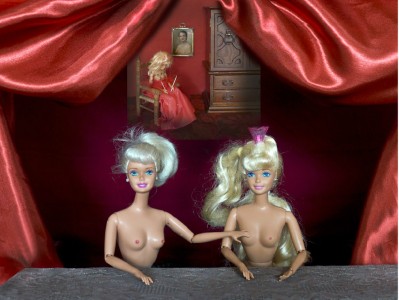
Diane: I belonged to Women’s Caucus for all the right reasons, I wanted to discuss art at what I might call an intellectual level, (that never happened) and I wanted an avenue to display my work.
As I grew more and more involved with the book arts, Women’s Caucus became less and less valuable to me. And now that I am becoming less and less involved with the book arts, BABA is declining in importance. Poetry is, I believe, primarily a social group made up of people with like interests. We discuss books, movies, plays, etc. And poetry, mostly modern current poets. Generally speaking I am a somewhat social person and enjoy the company of others. Even more so when we have similar interests. Probably my favorite group is Jumpstart which was a branch of the original BABA: The South Bay Bookies, a small encouraging group with nothing more in mind than showing and asking for feedback. Jumpstart is very small and we take the time to go into great depth each persons work and problems. Also we don’t confine the content to the book arts per se.
Whirligig: Your most recent series of photographs star Barbie in Art Historical images. Tell us about this work.
Diane: After finally completing the draining experience of writing my memoir, I was really at loose ends, completely blank as for inspiration. I wanted to return to my first love, photography; and I seriously needed to upgrade my photoshop skills after years of abandonment. So I signed up for a photoshop class at Foothill College with Ron Herman. It was the collage assignment that inspired me to use a Barbie doll as one of the elements. That was the seed that sent me on my way: finding suitable known works of art where I could photograph an appropriate background and replace the inhabitants with Barbie dolls. It has been an enjoyable challenge for me. Both the required photoshop skills but also the resourcefulness to, when necessary, improvise backgrounds. Also I love seeing the repetitiously benign, silly facades these Barbies do so well.
Whirligig: What do you plan to do with the Barbie series?
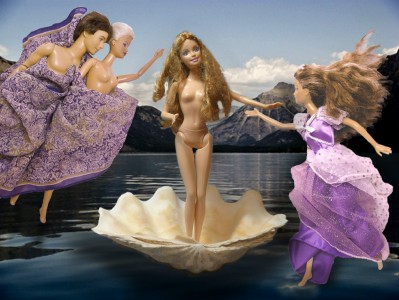
Diane: I’d sure like to do something. I feel a need for applause of some sort for the amount of time, and work it involved. My Jumpstart group nixed my idea to flesh it out with writing and making a Blurb book. Debbie Kogan suggested a calendar because there are 12 images. Also possibly the Altered Barbie Show in San Francisco. Any sought after applause has a better chance of success if I had a website. I’m working on it.
Whirligig: Your work is political, but not politicizing. Can you talk about this?
Diane: My work is not overtly or often not even consciously political. It is more a byproduct of my main thrust: which is, much like the Barbies, I just want to have fun. One way is by demythologizing the lofty status of past artworks.
Whirligig: It seems that you have strong opinions about the art world. Is this a response to the grad program at San Jose State or something else? Elaborate please.
Diane: I do not have strong opinions about the art world. Other than it takes itself too seriously. As for demythologizing, that process could and should be applied to almost anything that is taken too seriously. Or given too lofty a status. Remember, I think all this seriousness is a big joke.
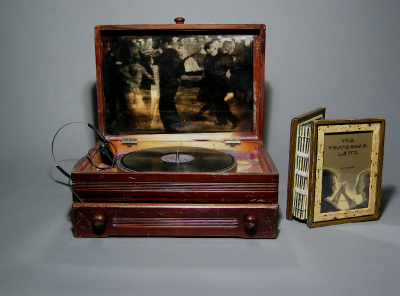
Whirligig: Several of your artist’s book projects are unique sculptural objects which are not exactly nostalgic, but are very much about memory and reflecting back. Can you talk about these works and how you came to make them?
Diane: The two you have to be referring to are The Tennessee Waltz and The Mailbox Book. The first one, The Tennessee Waltz, was definitely art as therapy. It was a means for a character in my past, my 20 something being whom I no longer have any resemblance to or relationship with, to have her very much deserved day in court. It is an amazing unexplainable phenomenon to spend great creative energy for a project and when successfully completed, to bring satisfaction, requiring no need for applause.

The other was The Mailbox Book which was initiated by a pass thru an antique/junk store and happening upon this segment of a mailbox wall such as was in my grandmother’s apartment building where she lived and where I often stayed. I had been taking a lot of memoir writing classes with no idea of why, so had a lot of raw material. I was so enamored of this box, that I set to work to make something of it. I ended up with a rather whimsical piece consisting of actual letters from the various younger Dianes. The reading of the letters was accompanied by “I’m going to sit right down and write myself a letter” music.
Whirligig: Your book Taxidermy is an excellent example of a book’s form being married to its content. Tell us about this work.


Diane: I was cleaning out and disposing of scads of old photographs when I came across one of my disbanded projects while I was a student at San Jose State. I was going to make a survey of several taxidermy studios. Both my early childhood familiarity with the products of taxidermy in Glacier Park, Montana, plus my desire to explore the practice in depth drew me to this endeavor. While looking at the photographs I recalled the close personal involvement I had with these various taxidermists who proudly believed their craft to be an art form. Both the photographic quality and the unusual subject matter of these images convinced me to save them for a future artist’s book. One of the goals of a successful artist book was to have all the parts of the book —the cover, the pages, text, binding, etc. be interconnected. In other words, everything had to be there for a reason. The workplaces I visited had peg board for walls which I used for book covers. My original 8 x 10 black and white photographs, were attached to cardboard pages, and duct tape bound it all together.
Whirligig: What artwork has been the most rewarding for you to make?
Diane: I think in the beginning, when I had no filter, no expectations, no requirements. It was just me and my camera, just looking, seeing, framing, recording, reproducing. Everything was for the first time. I had high confidence in my abilities to see—a first requirement in photography—lots of energy and enthusiasm. But I’ve also enjoyed my latest endeavor, the Barbie Series. The early photographic journeys were unstructured, unplanned, completely spontaneous. The latest, the Barbie series, is the diametrical converse. Go Figure!
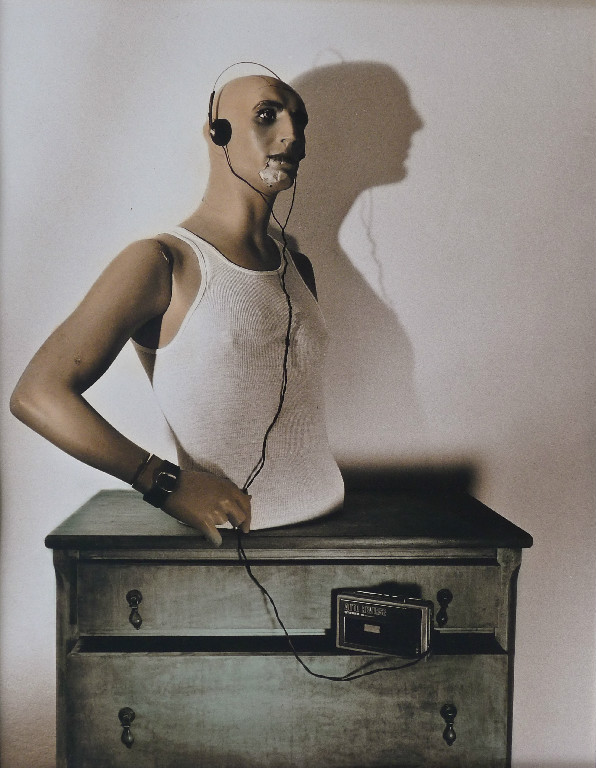
Whirligig: What artwork do you feel is most significant or if there could be only one, the one you would want to be identified with?
Diane: I think (without giving it too much thought) probably The Tennessee Waltz. It’s a sculptural book arts piece. It was the most meaningful to me personally. And, like my memoir, was therapeutic. But unlike my memoir, I believe it was more universal.
Whirligig: What do your respond to in other people’s artwork? What do you look for?
Diane: My first response, unconventional—but not for the sake of unconventionality. I mean a new take on composition, color relationships. Any artwork that translates as ambiguous. I like complicated convoluted pieces that you can’t absorb on first pass. I recently came upon something I wrote in 1995 that addresses this very question (and says it far more succinctly) “. . . work that catches you off guard and makes you think, work that somehow undermines your equilibrium, forcing you to look at things from a different perspective.”
Whirligig: You have a history of harboring small, sometimes exotic, critters. Will you share a favorite story about these?
Diane: I get very emotionally involved with my critters. Not counting my three cats, I have seven fish, two frogs, two toads, two turtles, and seasonal caterpillars. I’m very protective. It seems the lower the life form the more protective I am. Far more than with human children.
Whirligig: What is your philosophy regarding how to live an engaged life?
Diane: That’s a huge philosophical question. The kind of question I’ve given little thought to for years, but a question that in the past I gave great credence to. So . . . trying to remember, I believe my conclusion was that most people’s primary goal was to be happy. After a lot of thought I finally concluded that you need to shift the emphasis, rather than trying to make yourself happy, the true path to happiness was to find a goal, a purpose outside yourself, something that didn’t involve you personally, yet a worthy goal that engaged you.
Today I am, compared to my earlier struggles, pampered and spoiled. My primary focus is doing whatever pleases me. I find making art is a great energizer, and it really does take you outside yourself, like shifting the focus. So, in a way, it satisfies my much earlier formula for happiness.
However, I really do believe that much of the capacity for happiness is genetic, and that I’ve been blessed with the “happy gene”.
Whirligig: Many people comment on your delightful and witty demeanor. What is your source of joy?
Diane: I am an inveterate tease. I think I have an extra sensor which gives me the ability to detect too much seriousness. I get a perverse satisfaction when I expose someone’s misguided emphasis. I tell myself it’s theraputic because we all, including me, take ourselves too seriously.
Diane’s website: www.dianecassidy.com
Images from the top: After Manet’s dejeuner sur L’herbe, Pat & John, Michelle & Trisha, Incubus, After Millais’ Ophelia, After School of Fountainbleu, After Boticelli’s Birth of Venus, Tennessee Waltz, Mailbox, Taxidermy (cover), Taxidermy (detail), What is the Frequency, Kenneth? All images copyright and courtesy of Diane Cassidy.
